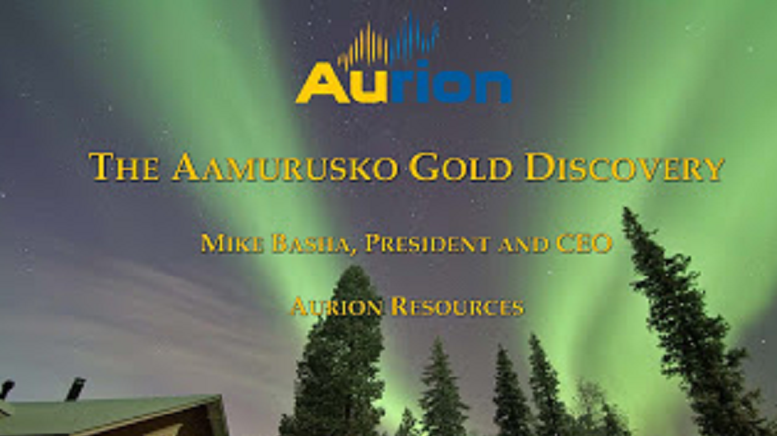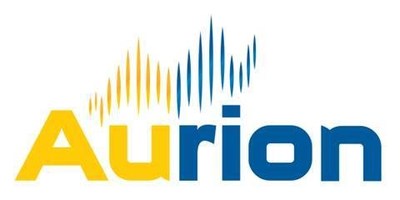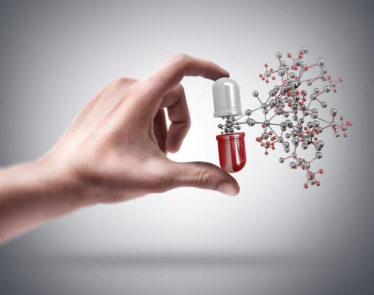
Canada NewsWire
ST. JOHN’S, March 13, 2019
TSX-V: AU
ST. JOHN’S, March 13, 2019 /CNW/ – Aurion Resources Ltd. (TSXV:AU) (“Aurion” or the “Company”) provides an update on the recently completed 12,000 m drilling campaign at the Aamurusko and Notches prospects on its Risti Project in northern Finland.
image: https://mma.prnewswire.com/media/834980/Aurion_Resources_Ltd__Aurion_Extends_Strike_of_Near_Surface_Mine.jpg

Highlights
- New near-surface gold intercepts extend Aamurusko mineralized shoot to 100 m strike
- 23.40 g/t Au over 0.50 m intersected in drillhole AM19080 at Aamuursko
- 24.80 g/t Au over 0.50 m intersected in drillhole AM19088 at Aamurusko
- Mineralized gold-bearing conglomerate encountered in drilling at Notches
- 20.30 g/t Au over 0.65 m intersected in drillhole NT18006 at Notches
- Significant core loss experienced in several holes at Aamurusko
- Please follow the link to maps and sections:
To date, sixty-eight of eighty-two (83%) drillholes completed at Aamurusko (Main and Northwest) have intersected gold mineralization. Seventeen have intercepts of 15 g/t Au or higher. Gold mineralization has been intersected in multiple rock types to a depth of 350 m below surface. Mineralization remains open at Aamurusko.
Drilling over 250m of the eastern extent of the Aamurusko boulder field continues to support the presence of a mineralized shoot. Mineralized boulder fields stretching 1 km to the west of these intercepts remain unsourced, suggesting additional near-surface mineralization is present.
At Notches, approximately 3 km east of Aamurusko, near surface gold mineralization encountered in conglomerate may represent a new style of mineralization on the Risti property. Conglomerate hosted gold has been encountered in several world class gold camps including Timmins and widely across the Birimian.
Aamurusko Summary
Gold mineralization intersected at shallow depths (40-60 m vertically from surface) expands known mineralization in an area that is now estimated to be 100 m long in an east-west orientation with a sub-vertical distance of 110 m. Multiple high-grade (anything greater than 10 g/t Au is considered high-grade here) intercepts occur in this area. While true widths are unknown at this time the ability to successfully target and intercept gold mineralization with drill step outs both vertically and horizontally suggests that the mineralization appears to form part of a coherent body or shoot.
This mineralization lies proximal to the faulted/sheared contact between a gabbro intrusive and sedimentary rocks. Mineralization remains open at depth.
The Aamurusko boulder field comprising 1,210 angular boulders that assayed an average of 25 g/t Au (previously disclosed) is > 1.3 km wide. The current drilling has been focused over an east-west distance of approximately 250 m at the eastern extent of the boulder field. This suggests that the mineralization encountered there is only one source of the many high-grade boulders at Aamurusko. Gold mineralization was also intersected in 500 and 800 m step out drillholes to the west-northwest providing further evidence that additional near surface gold mineralization may exist in the same geological/structural setting west of the current main focus of drilling.
Most of the drilling completed from November to February was done with a track-mounted drill rig which is not ideal due to topography. This resulted in significant core loss in three holes (see “Aamurusko Drilling”). Beginning in Q2 a more optimal north-to-south drilling orientation will be employed using a heli-portable drill rig.
Drilling is anticipated to recommence in the coming weeks.
Notches Summary
Six drillholes (total of 714 m) were completed at Notches.
Two drillholes were completed to test a new previously undocumented style of gold mineralization, encountered in a single trench (# 17), where a pervasively altered and mineralized 10-15 m wide polymictic conglomerate unit cut by a quartz vein stockwork and veins up to 1.4 m wide was exposed. Both drillholes intersected the silica-sulfide altered and mineralized conglomerate with 1 to 15% sulfides (pyrrhotite-pyrite-chalcopyrite-galena) plus magnetite, tourmaline, rare visible gold, and extensive quartz veining. The conglomerate assayed up to 8.24 g/t Au over 0.60 m and individual quartz veins assayed up to 20.30 g/t Au over 0.65 m. The best assay from surface saw-cut channel samples of the polymictic conglomerate was 3.2 g/t Au over 4.40 m including 8.94 g/t Au over 0.87 m. The best channel sample from the vein was 3.54 g/t Au over 0.6 m.
This conglomerate has been mapped over several hundred metres and has a coincident weak to moderately strong ground magnetic signature, likely due to the presence of magnetite and pyrrhotite and which suggests the mineralized conglomerate may extend some distance. It also represents a new target type across the property.
The four other widely spaced drillholes were drilled to obtain structural data. Two of these intersected narrow zones of gold mineralization.
Aamurusko Drilling Results
Drillhole AM19087 intersected quartz veins assaying 4.21 g/t Au over 0.50 m from 60.15 to 60.65 m. This drillhole was drilled approximately 20 m east of drillhole AM19081 which intersected quartz veins assaying 24.50 g/t Au over 4.75 m from 48.80 to 53.55 m. Drillhole AM18064 drilled a further 25 m east of AM19087 intersected 1.62 g/t Au over 0.90 m from 78.10 to 79.00 m. These intercepts occur proximal to the sheared gabbro-sediment contact and may extend the strike of the mineralized zone/shoot to 100 m.
Drillholes AM19091 to 93 were drilled to test for additional downplunge high-grade mineralization. Due to difficult drilling conditions in these holes and massive core loss proximal to the target, core recovery was poor and inadequate samples were collected for assaying. These drillholes will be re-drilled from another orientation to get a more optimal drillcore intercept.
Drillhole AM19080 drilled approximately 25 m further to the east intersected quartz veins assaying 23.40 g/t Au over 0.50 m from 172.8 to 173.30 m. This mineralized zone is hosted within the sediments. There was no significant veining intersected at the gabbro-sediment contact in this drillhole.
Drillhole AM19088 drilled approximately 100 m further to the east intersected quartz veins assaying 24.80 g/t Au over 0.50 m from 50.40 to 50.90 m. This drillhole was a down-dip test of mineralization intersected in drillhole AM18035 which assayed 12.45 g/t Au over 5.20 m from 53.50 m to 58.70 m depth.
Notches Drilling Results
Drillholes NT18001 and 004 intersected mineralized quartz veining in altered sandstone. The best intercepts were 1.82 g/t Au over 0.75 m and 4.54 g/t Au over 0.80 m, respectively.
Drillholes NT18005 and 006 were drilled under a trench which encountered a mineralized and altered polymictic conglomerate. NT18005 intersected an 11 m wide pervasive silica-sulfide altered and mineralized conglomerate with 1 to 15% sulfides (pyrrhotite-pyrite-chalcopyrite-galena) plus magnetite, tourmaline and rare visible gold, and extensive quartz veining. The conglomerate assayed 2.99 g/t Au over 2.10 m including 8.24 g/t Au over 0.60 m.
Drillhole NT18006 intersected a 14 m wide mineralized and altered conglomerate approximately 50 m downdip which returned a best assay of 0.77 g/t Au over 1.60 m. A quartz vein was intersected further up in the drillhole which assayed 20.30 g/t Au over 0.65 m.
|
Drilling Highlights |
|||||||
|
Aamurusko |
|||||||
|
HOLE_ID |
Azimuth |
Dip |
FROM_m |
TO_m |
Width_m |
Au_ppm (g/t) |
Comments |
|
AM17013 |
123.85 |
124.70 |
0.85 |
5.15 |
|||
|
AND |
200.65 |
202.30 |
1.65 |
4.46 |
|||
|
incl |
201.15 |
201.67 |
0.52 |
7.20 |
|||
|
AND |
204.55 |
205.10 |
0.55 |
8.82 |
|||
|
AM17015 |
230.00 |
233.00 |
3.00 |
3.88 |
|||
|
incl |
231.00 |
232.00 |
1.00 |
10.15 |
|||
|
AM17020 |
177.50 |
178.00 |
0.50 |
11.20 |
|||
|
AND |
185.30 |
185.80 |
0.50 |
4.26 |
|||
|
AND |
211.00 |
212.00 |
1.00 |
4.96 |
|||
|
AM17021 |
178.50 |
179.00 |
0.50 |
6.82 |
|||
|
AM18024 |
227.00 |
228.00 |
1.00 |
4.17 |
|||
|
AM18026 |
110 |
-55.4 |
181.90 |
182.50 |
0.60 |
25.00 |
|
|
AND |
190.30 |
191.30 |
1.00 |
5.03 |
|||
|
AM18035 |
200 |
-44.5 |
26.30 |
28.04 |
1.74 |
9.62 |
|
|
incl |
26.30 |
26.94 |
0.64 |
23.30 |
|||
|
AND |
36.65 |
38.20 |
1.55 |
8.74 |
|||
|
incl |
37.18 |
37.70 |
0.52 |
24.80 |
|||
|
AND |
53.50 |
58.70 |
5.20 |
12.45 |
|||
|
incl |
53.50 |
54.05 |
0.55 |
7.46 |
|||
|
incl |
54.50 |
55.00 |
0.50 |
66.70 |
|||
|
incl |
57.65 |
58.14 |
0.49 |
54.30 |
|||
|
AM18042 |
180 |
-45.0 |
116.10 |
119.00 |
2.90 |
789.06 |
|
|
incl |
116.10 |
116.75 |
0.65 |
3510.00 |
1.1 m of lost core from 116.75 to 117.85 m; assigned a value of 0 ppm |
||
|
incl |
117.85 |
119.00 |
1.15 |
5.89 |
|||
|
AM18051 |
180 |
-58.0 |
114.30 |
115.40 |
1.10 |
17.46 |
25 m downdip undercut of 42 |
|
incl |
114.95 |
115.40 |
0.45 |
39.40 |
|||
|
AM18053 |
163 |
-59.0 |
202.50 |
203.70 |
1.20 |
4.76 |
Highly anomalous Pb-Zn-As |
|
incl |
202.50 |
203.00 |
0.50 |
9.12 |
Highly anomalous Pb-Zn-As |
||
|
AM18056 |
180 |
-45.0 |
31.00 |
32.00 |
1.00 |
4.22 |
|
|
AM18061 |
155 |
-61.0 |
30.45 |
31.45 |
1.00 |
6.46 |
|
|
AM18062 |
164 |
-58.2 |
47.00 |
47.55 |
0.55 |
7.83 |
|
|
AM18063 |
150 |
-55.0 |
25.00 |
26.00 |
1.00 |
4.95 |
|
|
AM18064 |
180 |
-45.0 |
129.70 |
130.30 |
0.60 |
13.70 |
Hole terminated in mineralization at 130.3 m depth |
|
AM18075 |
350 |
-44.3 |
176.00 |
177.80 |
1.80 |
17.06 |
|
|
incl |
176.00 |
176.60 |
0.60 |
26.20 |
|||
|
incl |
176.60 |
177.25 |
0.65 |
23.00 |
|||
|
AND |
246.35 |
250.00 |
3.65 |
4.56 |
|||
|
incl |
246.35 |
246.85 |
0.50 |
29.20 |
|||
|
AM18077 |
0 |
-45.2 |
41.45 |
42.00 |
0.55 |
9.43 |
|
|
AND |
43.00 |
43.60 |
0.60 |
10.60 |
|||
|
AM19080 |
0 |
-43.9 |
172.80 |
173.30 |
0.50 |
23.40 |
1.62% Pb and 3.13% Zn |
|
AM19081 |
5 |
-39.0 |
48.80 |
53.55 |
4.75 |
24.50 |
|
|
incl |
51.20 |
52.00 |
0.80 |
45.70 |
|||
|
AM19082 |
320 |
-39.2 |
40.00 |
44.00 |
4.00 |
42.28 |
|
|
incl |
41.90 |
43.30 |
1.40 |
110.90 |
|||
|
incl |
41.90 |
42.60 |
0.70 |
172.00 |
|||
|
incl |
42.60 |
43.30 |
0.70 |
49.80 |
|||
|
AM19083 |
325 |
-39.2 |
114.65 |
115.60 |
0.95 |
5.00 |
|
|
AM19087 |
357 |
-40.3 |
60.15 |
60.65 |
0.50 |
4.21 |
|
|
AM19088 |
138 |
-49.9 |
50.40 |
50.90 |
0.50 |
24.80 |
|
|
Notches |
|||||||
|
NT18001 |
162 |
-43.8 |
63.35 |
64.10 |
0.75 |
1.82 |
|
|
NT18002 |
162 |
-44.3 |
NSV |
||||
|
NT18003 |
162 |
-44.1 |
NSV |
||||
|
NT18004 |
110 |
-45.4 |
27.80 |
28.60 |
0.80 |
4.54 |
|
|
NT18005 |
75 |
-45.1 |
31.40 |
33.50 |
2.10 |
2.99 |
|
|
incl |
31.40 |
32.00 |
0.60 |
8.24 |
|||
|
AND |
54.50 |
55.50 |
1.00 |
2.23 |
|||
|
NT18006 |
75 |
-43.7 |
27.40 |
29.05 |
1.65 |
8.23 |
|
|
incl |
27.40 |
28.05 |
0.65 |
20.30 |
|||
|
AND |
84.20 |
85.80 |
1.60 |
0.77 |
|||
|
All widths are core widths. True width is not known at this time. |
|||||||
|
All assay values are uncut. |
|||||||
Comments
“Drilling targeting has become more refined resulting in the discovery of near surface high-grade gold mineralization. With short 20-25 m step outs we may be defining a coherent zone of mineralization. Drilling has been focused over a distance of 250 m at the eastern extent of the >1.3 km wide high-grade Aamurusko boulder field. Results to date suggest potential for additional similar zones of gold mineralization along strike to the east and west. Gold mineralization intersected in a 500 m step out to the west supports this premise.”, commented Mike Basha, President and CEO. “Additionally, inaugural drilling at Notches has encountered a new style of gold mineralization in the conglomerates. This represents a new target type throughout the whole Risti project. This will be followed up aggressively in the spring”.
Background
The geological setting of the Risti project has many similarities to prolific gold-rich orogenic gold belts globally, specifically the Timmins camp of the Abitibi geological province of Northern Ontario. The Aamurusko zone appears to be underlain by young unconformable clastic rocks (meta-sandstones and conglomerates) of the Kumpu Group. These Kumpu Group conglomerates resemble the Timiskaming conglomerates of the Timmins and Kirkland Lake area of the Abitibi province and occur in a similar geo-tectonic setting (both represent the youngest stratigraphic sequence within their respective belts). The Kumpu Group and the Timiskaming group were deposited in late orogenic extensional basins. They form in relation to major movement along regional faults or deformation zones. In the Abitibi province, many high-grade, multimillion-ounce gold deposits are temporally and spatially associated with the Timiskaming conglomerates (or their equivalents) in close proximity to major regional deformation (fault) zones such as the Porcupine-Destor or Cadillac Lake-Larder Lake deformation zones. The Kumpu Group appears to have been deposited in a similar geological setting adjacent to the Sirkka shear zone, which is a major deformation zone in the Central Lapland Greenstone Belt. Strong alteration including fuchsite, tourmaline, iron carbonate, albite and quartz veining is seen along the entire length of this structure.
Quality Assurance and Quality Control
All samples were delivered to ALS Minerals preparation facility in Sodankyla, Finland where sample preparation work was completed. All analytical work was completed at ALS Minerals facility in Loughrea, Ireland. ALS Minerals is an internationally accredited lab and are ISO compliant (ISO 9001:2008, ISO/IEC 17025:2005). All samples were analyzed for gold using the Au-AA26 procedure (50g fire assay with AAS finish: Lower Detection Limit 0.01 g/t gold; Upper Limit – 100 g/t gold). Any samples that returned overlimit values (>90.0 g/t gold) or had visual indication of mineralization, such as visible gold or prospective vein intervals (>90.0 g/t gold) were analyzed by Au-SCR24 1kg, Screen Fire Assay Au (0.05-1,000 ppm) by 1kg screen fire assay (50g nominal sample weight). The sample pulp (1kg) is passed through a 100 micron stainless steel screen. Any material remaining on the screen (>100 micron) is retained and analyzed in its entirety by fire assay with gravimetric finish and reported as the Au (+) fraction. The material passing through the screen (<100 micron) is homogenized and two sub-samples are analyzed by fire assay with AAS finish. The average of the two AAS results is taken and reported as the Au (-) fraction result. All three values are used in calculating the combined gold content of the plus and minus fractions. The gold values for both the (+) 100 and (-) 100 micron fractions are reported together with the weight of each fraction as well as the calculated total gold content of the sample.) Multi-element analysis (ME-ICP61, four-acid digestion, 35 element ICP-AES) was completed on all samples. Certified standards and blanks were inserted every 30 samples. ALS has its own QA/QC protocol using standards, blanks and duplicates.
For more information on these projects please visit our website at www.aurionresources.com
Forward-Looking Statement
Certain statements contained in this release constitute forward-looking information. These statements relate to future events or future performance. The use of any of the words “could”, “intend”, “expect”, “believe”, “will”, “projected”, “estimated” and similar expressions and statements relating to matters that are not historical facts are intended to identify forward-looking information and are based on the Companies’ current belief or assumptions as to the outcome and timing of such future events. Actual future results may differ materially. The forward-looking information contained in this release is made as of the date hereof and Aurion is not obligated to update or revise any forward‑looking information, whether as a result of new information, future events or otherwise, except as required by applicable securities laws. Because of the risks, uncertainties and assumptions contained herein, investors should not place undue reliance on forward‑looking information. The foregoing statements expressly qualify any forward‑looking information contained herein.
On behalf of the Board of Directors,
Michael Basha, Chief Executive Officer
Neither the TSX Venture Exchange nor its Regulation Services Provider (as that term is defined in the policies of the TSX Venture Exchange) accepts responsibility for the adequacy or accuracy of this release.
SOURCE Aurion Resources Ltd.
Original Press Release: stockhouse.com












